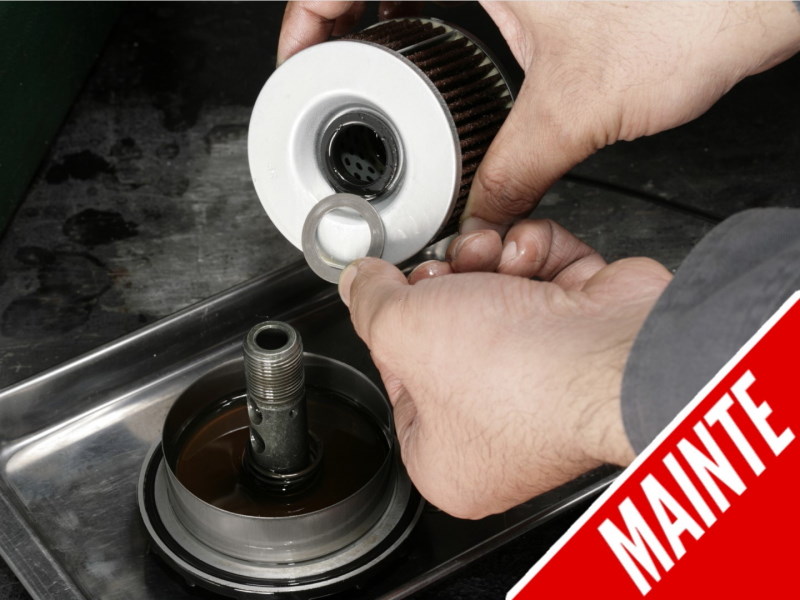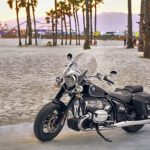The oil filter removes dirt from the oil that circulates inside the engine, and it is generally recommended that it be replaced every two oil changes. Nowadays, the cartridge type is the most common type, but there are also many built-in types where the element is installed in the engine. Some of the built-in types combine several parts, so it is important to check them so as not to lose them in dirty oil.
Oil filters are essential for removing impurities and foreign matter
 When you loosen the oil filter cover bolt, oil will flow out from the outer circumference of the cover like a rain shower. some models like Z2 have a drain bolt on the filter cover as well, in that case, pull it out from the drain bolt first. It is recommended to prepare a drain pan with a large area to avoid spilling the oil flowing out from around the cover.
When you loosen the oil filter cover bolt, oil will flow out from the outer circumference of the cover like a rain shower. some models like Z2 have a drain bolt on the filter cover as well, in that case, pull it out from the drain bolt first. It is recommended to prepare a drain pan with a large area to avoid spilling the oil flowing out from around the cover.
 Thanks to the exhaust layout of the external exhaust system, I were able to remove the element without removing the muffler. The edges of the filter cover and oil filter plate are sharp, so be careful not to cut your fingers or hands while removing them.
Thanks to the exhaust layout of the external exhaust system, I were able to remove the element without removing the muffler. The edges of the filter cover and oil filter plate are sharp, so be careful not to cut your fingers or hands while removing them.
A new engine that has just been shipped from the manufacturer may still have metal burrs that were not removed after machining the internal parts such as the crankcase and transmission. Also, if the motorcycle starts per from zero kilometers, dust and chips left on the edges of various parts may fall off, and wear and friction may occur as the parts operate under heat for the first time.
Therefore, it is recommended to break-in a new motorcycle without performing it at full throttle and to change the oil for the first time after a short distance of about 1000km. In the case of a cartridge type oil filter, the inside of the filter element cannot be seen, but in the case of a built-in type where the filter element is placed inside the engine and covered with a cover, metal fragments may be visible behind the finely bent folds of the element.
The oil filter catches more than just swarf from the new motorcycles. The hard carbon deposits that form when oil and gasoline are altered over time can have a negative effect on metal and bearings, but the oil filter catches them before they can cause problems. Also, some riders like to try different additives, but in some cases, the ingredients of the additives may react with each other and form a gel. In such a case, the oil filter becomes a bulwark.
However, if the element continues to catch foreign substances and the filtration area of the element decreases, and less oil can pass through, a problem will occur. The oil filter is the first place where the oil pumped out by the oil pump passes through, and in the same way that blood pressure rises when blood vessels become clogged with cholesterol, oil pressure rises when there is a blockage here. When the filter is clogged, the lubrication inside the engine becomes stagnant, which can cause serious problems. The oil filter incorporates a bypass valve that allows oil to pass through the filter and into the engine when the oil pressure rises above a certain level.
Because of this, even if the filter is all clogged up in the extreme, the engine parts will not suddenly lose lubrication. However, since the oil has not passed through the filter, dirt will travel around the engine parts with it. It would take a lot of miles of poor oil management to get into such a bad condition, and it is unlikely that a rider who loves motorcycles would ever get into such a situation.
However, it's not enough to just keep changing the oil, you should also change the oil filter regularly to prevent problems.
 Clean the oil from the exhaust system and oil pan with parts cleaner, and wipe off the oil in the filter case. The same goes for the seating surface where the O-ring around the outside of the cover contacts.
Clean the oil from the exhaust system and oil pan with parts cleaner, and wipe off the oil in the filter case. The same goes for the seating surface where the O-ring around the outside of the cover contacts.
- Point 1: The oil filter is important not only when breaking in a new motorcycle, but also when the motorcycle has been used for a long time.
- Point 2: If the oil filter is clogged, the oil will circulate through the bypass valve without passing through the filter.
Be careful with the built-in type as there is a possibility of incorrect assembly and oil leakage.
 On GPZ400F and Zephyr, the oil filter plate (pressed cup) attaches to the oil filter cover side, that is, the bottom side of the filter. At the base of the cover bolt, there is a spring that pushes the filter element to the engine side, and between the spring and the rubber grommet of the element, there is a thin washer that you are holding with your left hand. Without this washer, the spring would bite into the grommet and the spring tension would be lost. When you pull out the element from the cover bolt, the washer sticks to the grommet side, and it is a common mistake to throw away the element without noticing it, so be careful.
On GPZ400F and Zephyr, the oil filter plate (pressed cup) attaches to the oil filter cover side, that is, the bottom side of the filter. At the base of the cover bolt, there is a spring that pushes the filter element to the engine side, and between the spring and the rubber grommet of the element, there is a thin washer that you are holding with your left hand. Without this washer, the spring would bite into the grommet and the spring tension would be lost. When you pull out the element from the cover bolt, the washer sticks to the grommet side, and it is a common mistake to throw away the element without noticing it, so be careful.
 The oil that came out of the drain bolt in the oil pan was clear, but the oil at the bottom of the oil filter plate was black and adhered like viscosity. In this engine, the plate is on the bottom of the filter element, so it is hard to see the dirt, but in engines where the plate covers the filter, this kind of dirt also adheres to the filter element.
The oil that came out of the drain bolt in the oil pan was clear, but the oil at the bottom of the oil filter plate was black and adhered like viscosity. In this engine, the plate is on the bottom of the filter element, so it is hard to see the dirt, but in engines where the plate covers the filter, this kind of dirt also adheres to the filter element.
 Clean each part with parts cleaner and kerosene. The filter bolt is hollow and has several horizontal holes, and a bypass valve consisting of a spring and a steel ball is built inside. The engine oil from the oil pump goes from the outer circumference of the filter element to the center, through the filter bolt and is used to lubricate the engine parts.
Clean each part with parts cleaner and kerosene. The filter bolt is hollow and has several horizontal holes, and a bypass valve consisting of a spring and a steel ball is built inside. The engine oil from the oil pump goes from the outer circumference of the filter element to the center, through the filter bolt and is used to lubricate the engine parts.
The cartridge type installed on the outside of the crankcase and the built-in type installed inside the engine has different components, but the function of the oil filter is the same. Looking at the flow of the times, many out-of-print and old motorcycles introduced before 1980s are built-in type, and after that, cartridge type is mainstream.In addition, many trail models, which are often used on rough terrain and forest roads, use a built-in filter to reduce the risk of damage to the external engine. Also, many trail models that are used on rough terrain or forest roads have a built-in filter to reduce the risk of damage to the filter attached to the outside of the engine.
There are two patterns of built-in types. One is the type where the filter element is simply held in place by a cover, such as on the Yamaha SR400 and Serow. The other type, common on Kawasaki models such as the Z1/Z2 and GPZ900R, is a bolt that goes through the center of the filter cover and element. The CB750 Fore and CB750F have a deep cup-shaped filter cover that attaches to the outside of the crankcase.
The GPZ400F type oil filter, which is installed on the bottom of the crankcase, has been used in successive four-cylinder models from the Z1/Z2 to the GPZ900R, ZZR1100, and ZRX1100. Not only four-cylinder engines, but also two-cylinder engines such as the GPZ250R and ZZR250 are of this type. On the other hand, the ZZR400, ZXR400/750, and Ninja 250 are equipped with the cartridge type even for four-cylinder engines.
The Kawasaki built-in oil filter on the bottom of the filter case has different features from the cartridge type, such as the oil inside the filter case drips from the outside when the bolt in the center of the filter cover is loosened. (Some external mufflers are difficult to install and remove even with the cartridge type).
On top of that, this type of Kawasaki filter requires attention to the combination of parts. When the element is removed from the removed oil filter, the bolt that goes through it has a spring, washer, and a shallow cover that covers the element. The spring and washer are located between the element and the filter cover, so if you unintentionally remove the element you may lose the assembly sequence. There is also a rubber grommet fitted in the centre of the element, so with a bit of thought, you should be able to see that it makes sense for the washer to go between the spring and grommet.
But, when you remove the element, you don't notice that the washer is stuck to the grommet, and you restore the new element without the washer.It seems that there are many examples. You need to pay attention to the cup which is made of pressed thin steel plate (Zephyr parts list says oil filter plate, GPZ250R says oil fence), because it depends on the model whether it is attached to the upper or lower part of the filter. The GPZ400F and Zephyr will be on the bottom, while the Zephyr 750 and ZRX1100 will be on the top. If you buy a used motorcycle that has been through multiple owners and you are not sure of the maintenance history, check the parts list or service manual to see what the parts consist of.
Furthermore, when replacing this type of oil filter, the O-rings around the outside of the cover and at the base of the cover bolts must also be replaced with new ones. Even if the O-ring is not deformed or elastic to the touch, oil leaking from this O-ring can be fatal to the engine. Also, if oil drips in front of the rear tire, it can cause the motorcycle to fall over.
Because of these many procedures, you may feel that maintenance is more troublesome compared to cartridge-type filters. This Kawasaki type filter in particular is certainly a filter that has many points that require attention to work. However, as mentioned earlier, the condition of your engine depends on the oil filter, so don't be afraid to change it regularly.
 Be sure to replace the large diameter O-ring around the outside of the filter cover and the O-ring on the cover bolt. The thin washer between the spring and the element should also be ordered as a genuine part if it is not already in there.
Be sure to replace the large diameter O-ring around the outside of the filter cover and the O-ring on the cover bolt. The thin washer between the spring and the element should also be ordered as a genuine part if it is not already in there.
 Daytona Super Oil Filter is suitable for old and out-of-print models with increased filter creases to improve filtration performance. It works to reduce the wear inside the engine by removing foreign materials efficiently. The O-ring on the filter cover has been replaced, so the round cross-section of the O-ring is raised from the ring groove. O-rings that have been pressed against the oil pan for a long period of time and deformed flat may cause oil leaks due to reduced surface pressure.
Daytona Super Oil Filter is suitable for old and out-of-print models with increased filter creases to improve filtration performance. It works to reduce the wear inside the engine by removing foreign materials efficiently. The O-ring on the filter cover has been replaced, so the round cross-section of the O-ring is raised from the ring groove. O-rings that have been pressed against the oil pan for a long period of time and deformed flat may cause oil leaks due to reduced surface pressure.
 The O-ring at the base of the cover bolt should also be replaced with a new one. This O-ring is crushed to provide a seal, so there is some resistance when inserting it into the filter cover. Inserting a degreased O-ring may cause the rubber to twist and break, so it is best to apply a thin layer of grease before setting it in place.
The O-ring at the base of the cover bolt should also be replaced with a new one. This O-ring is crushed to provide a seal, so there is some resistance when inserting it into the filter cover. Inserting a degreased O-ring may cause the rubber to twist and break, so it is best to apply a thin layer of grease before setting it in place.
- Point 1: When you remove the built-in type oil filter, check the assembly order of the internal parts.
- Point 2: When you are not sure about the parts configuration or assembly order, check the parts list or service manual.
See Accessories of DAYTONA
See KAWASAKI Moto Index Page
See Accessories for KAWASAKI GPz400F/F2
See Accessories for KAWASAKI Z1 (900 Super Four)
See Accessories for KAWASAKI Z2 (750RS, Z750 Four)



